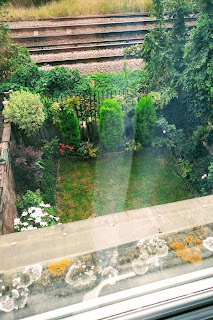How New Should it Be?
When I was in-between jobs last year (i.e. waiting for my
next office job to come through) I took the pleasure of working as a
‘Residential Gardener’ for most of the summer. Granted general clean-up duties
could sometimes be a drag, but there were many occasions where we would plant a
shipment of new plants and shrubs. Straight from the nursery, off the truck,
into the garden. This was always a lot of fun. Once everything was planted it
was then a case of standing back and simply appreciating the work we had just
done. One thing I used to sometimes notice was the mild apprehension on a
client’s face once everything was planted. You could read their faces
sometimes; “This doesn’t really look like what I saw in last month’s ‘Gardens
Illustrated’ magazine.” Followed by a very hesitant, “So . . . these plants will
definitely grow and move into shape, yeah?” Yes, they most certainly will.
A newly planted garden design will usually look quite
bare, with lots of visible space between plants. At times a newly designed
garden can often appear disjointed but in fact this is actually a good sign of
foresight and sound horticultural practice, as it allows room for growth and
movement. To answer the question presented in the title, ‘How new
should it be?’ The simple answer is that some plants can be bought at full size.
Trees and hedges can be purchased and delivered at full size and not surprisingly
they look amazing. However, you need to bear in mind that the more fully grown
you want the plants to be the more expense they will cost you. Fact. This is a
very important aspect you will need to consider when you have an idea for your
garden and you’re thinking with a budget in mind.
As the roots of new shrubs explore the new soil they are growing
in, a new plant will establish much faster mainly due to the vitality a new
plant has. They will spread their roots into the ground very quickly, whereas a
larger tree may have trouble spreading its root-ball into different soil. A new garden can feel really slow to show any
signs of progress. But be assured as time moves on you begin to see plants and
shrubs become vigorous making them ideal for long-term planting. Like any kind
of growth; personal, creative, or otherwise, a garden takes time to come into
their own – sometimes as long as three years. But why worry about this? Serious
question; what is the hurry?
For me, I always find a garden’s progress almost like a
metaphor for personal growth. During the first year there’s a bit of
uncertainly. What works? What doesn’t work? There are patches of soil, gaps
even. In the second year, things are beginning to look more robust and rigorous.
And by the third year the garden (and the design idea behind it) will begin to
feel fully realised and finished.
I would often take the liberty of reassuring the client
that the image they saw which had so inspired them didn’t just happen. It
happens over time. It’s a work in progress. This is perhaps one of the more amazing
and rewarding things about having a garden and how it encourages you to not
think too much about how it’s all going. Because with regular attention it will
keep going and going. These finished gardens that you see in magazines, as it
were, have taken several years of growth to come into its own. In one of my
recent design projects (I am currently studying Garden Design), my tutor
instructed me to learn the art of plant spacing and to get an idea of the final
shape and size. In other words; allow room for plants and shrubs to establish
themselves and spread.
Why is this? The main reason is because large plants (in
order to reach that size) have been looked after and attended to over the
years. This requires a lot of time, effort, and know-how by a horticulturalist
(or at least a very good gardener). In some instances, it may even require
special facilities to make it all work. Another thing to consider is that if
you are insisting on large fully formed plants delivery to your house alone may
cost anywhere between £50-£100 for a special courier! Compared that to postage
cost of £5-£10 for small shrubs and plants. Also, you are drastically
restricting the range of plants to choose from because new and unusual
cultivars simply won’t be available to buy at full size. The fact is exciting
new cultivars can be risky for garden nurseries. All that time and effort to
grow to full size, and they don’t sell. At a smaller size with a more affordable
price tag the turnover is more likely.
Always remember to keep this in mind; a garden is a
living and growing organism, and therefore it is really, never complete . . .
it just keeps growing and evolving – one day at a time. Just like life, right?








Great blog! I've just planted lots of (looking almost dead as we approach winter) 9cm plants in my garden. Not quite the Gardens Illustrated look just yet! But I'll sneak in some forget-me-nots and self-seeded marjoram from other parts of the gardens to fill in the spaces temporarily whilst the new plants fill out. As you suggest, a lot of the joy is seeing the change happen, more so really, than having the end result. But it does tend to take a real love of gardens and a bit of time to appreciate this fact!
ReplyDelete